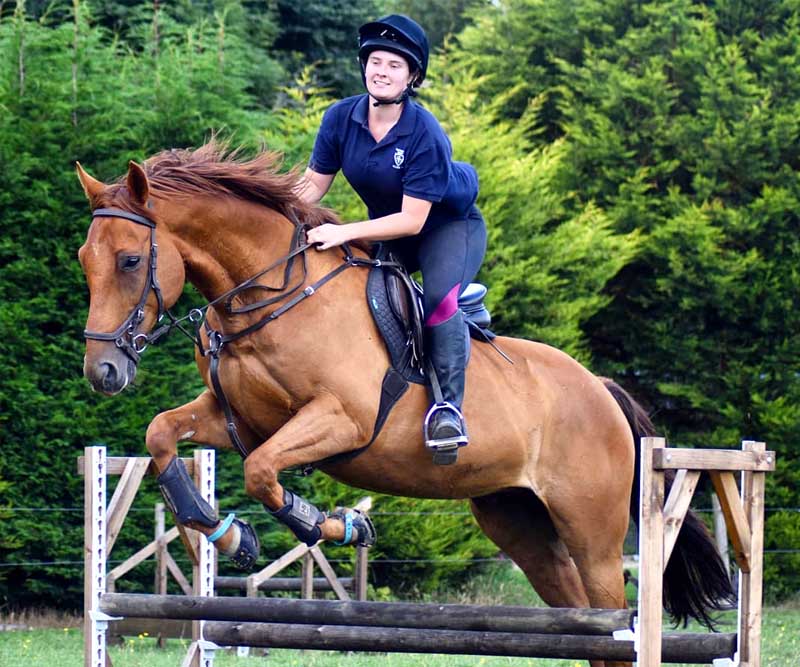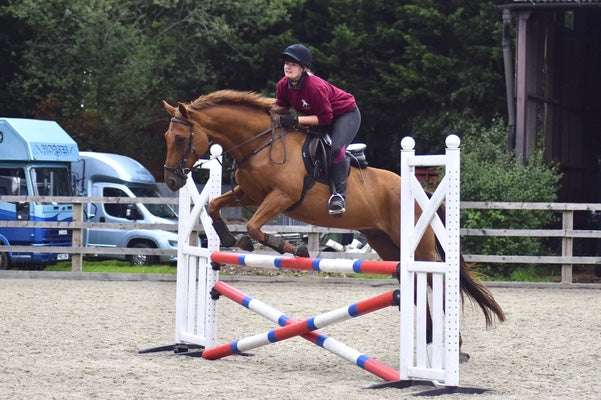
Going Barefoot can Help Prevent Recurring Hoof Abscesses
Share
Keeping your horse’s soles thick and well conditioned on various surfaces can do wonders to prevent abscesses from reccurring. Here is how you recognize if your horse has an abscess, a guide on how to treat abscesses at home and tips on preventing abscesses from keep coming back.
By Helle Maigaard Erhardsen
If your horse has never had an abscess before, it can be a scary experience – from being perfectly fine in the evening, the next morning he is so lame that he can’t take a single step. And when checking the affected hoof and leg, there might not even be anything visibly showing that could be causing the sudden severe lameness.
Though chances are that your horse has developed a hoof abscess. Think of an abscess like a deep-lying pimple, a small bacterial infection that has grown larger and larger and the accumulation of pus is building up pressure. This pressure pushes on nerves within the horse’s foot and often causes excruciating pain.
Like a pimple, the abscess will pop and drain itself eventually. Although the abscess can be situated in such a difficult spot, that your veterinarian wants to surgically drain it. This could be important, as some abscesses can spread deeper into surrounding structures in the hoof and cause additional soundness issues.
However, like when you squeeze a pimple to burst, it does give immediate relief, but there is also a high risk of contaminating the open wound with more bacteria, than if you had left it to burst on its own. As such, if your veterinarian isn’t worried about the position of the abscess, it is better to leave it to blow itself.
 A hoof abscess that has blown and is venting through the tip of the sole. Photo by Megan Bruce.
A hoof abscess that has blown and is venting through the tip of the sole. Photo by Megan Bruce.
Guide: How to Help a Hoof Abscess Pop without Draining it
Applying a poultice to help soften up the foot is the best way to encourage your horse’s abscess to burst and relieve the painful pressure. You can buy ready-made veterinarian wraps, but you can also make your own. One way is to mix 1/3 Epsom salt with 2/3 of wheat bran and add enough water to make it into a paste. Another option is to mix enough iodine or Betadine with ordinary table salt to make it into a paste.
- Shoes off immediately, if your horse is shod. Clean the hoof thoroughly with warm water. Put down a clean mat or tarp so the hoof doesn’t get contaminated if your horse decides to put his hoof down in the middle of the process.
- Add your homemade paste directly to the hoof and wrap it up with a bandage. To keep the hoof clean you can wrap further in duct tape and even add a thick water-repellent sock on top.
- Using hoof boots on top of the wrapped hoof has several advantages. First, hoof boots will provide a protective layer of shock absorption to the painful foot. Second, Scoot Boots in particular are designed with an ultimate degree of ventilation, which will help keep the foot clean and dry.
- Change the bandage at least once a day to prevent the poultice to dry out the hoof. In between bandaging, it is useful to soak the hoof in warm water with Epsom salt to help soften up the hoof further.
- Depending on where the abscess is located inside the hoof, it will create a vent to blow out where the hoof tissue is thinner and softer like at the tip of the frog, where the sole meets the hoof wall of just below the hairline on the outside of the hoof.
- Once the abscess has burst, you need to keep bandaging with poultice to keep the vent open to drain, until new tissue has grown and filled the vent. This usually takes three to four days. If the vent dries up and closes before all infection has been drained, the abscess is likely to reoccur.
 There is no need for stall rest whilst your horse is recovering from a hoof abscess if using hoof boots from Scoot Boots, as these boots will help keep the poultice in place and keep it dry and clean.
There is no need for stall rest whilst your horse is recovering from a hoof abscess if using hoof boots from Scoot Boots, as these boots will help keep the poultice in place and keep it dry and clean.
Causes of Hoof Abscesses in Horses and Connection to Laminitis
There are several common causes to hoof abscesses in horses. When the weather is very dry, the hoof can detract and create small cracks in the sole. Then after a sudden wet spell, the hoof expands and these small cracks can break open and allow bacteria to enter and get trapped inside, when the hoof detracts again.
Deep bruising of the hoof can also cause an abscess to develop and it’s not uncommon to see an abscess venting right next to a bruise on the sole. Though most commonly a hoof abscess occurs after a penetration of the foot – a sharp rock, piece of glass or a horseshoe nail. The penetration could happen several weeks before the infection has built up enough to make your horse lame.
Poor hoof health can make your horse more susceptible to developing abscesses. A stretched white line, also known as white line disease, creates a soft spot that’s easy for foreign objects to penetrate and infect. Further, even a minor inflammation of the laminae can make way for an abscess to develop. As such, an abscess can be a consequence of a mild laminetic episode that hasn’t become severe enough for you to notice.
In fact, laminitis and hoof abscesses share some of the same symptoms, which is another reason for having your horse checked by your veterinarian, if he shows some of the following signs:
- Lameness or complete avoidance to load a foot, especially the front limbs.
- Heat in the hoof as compared to the other hooves.
- An evident pulse or even throbbing in the affected lower limb.
Shod Horses can be Prone to Recurring Abscesses
If a horseshoe nail is driven into the dermal hoof tissue or touches on the white line of the hoof, the penetration can cause an infection to build up even if the nail is removed straight away. Some horses are particularly sensitive to foreign objects in their hooves and are at risk of developing abscesses every time they are shod. An example is eventer Megan Bruce’s Bugsy:
“I was getting very good at tubbing and poulticing, but it was becoming impossible to work him, as every time he recovered and we assumed he was ready to go out and start work, another abscess would spring up,” Megan said.
It wasn’t until Megan decided to go barefoot as a last resort, that Bugsy remained sound. As Bugsy was very foot sore when his shoes came off at first, Megan used Scoot Boots as protection during the transition from shod to barefoot:
“His Scoot Boots were doing a grand job and he would switch from a tender footed horse, always seeking soft ground and verges, to a happy confident horse who was keen to trot and canter.”
Although getting rid of the metal horseshoes is only the first step in building strong hooves that are better conditioned to resist recurring abscesses, as we will explore in the following.
 Megan Bruce and Bugsy competing barefoot in Scoot Boots.
Megan Bruce and Bugsy competing barefoot in Scoot Boots.
How going Barefoot can help prevent Hoof Abscesses
Megan Bruce described Bugsy’s feet as being classical Thoroughbred when he was shod: Thin soles, brittle hoof walls and very little hoof growth. As such, a horse like Bugsy would need to rebuild the health of his hooves before he can live happily without abscesses and the metal shoes that caused them.
First step is to look closely at your horse’s diet. Removing sugar and starch from his diet and supplying premium vitamins and minerals to fill his exact needs is utmost important. This will not only support healthy new hoof growth, but also help prevent white line disease and laminitis from occurring, which can lead to hoof abscesses.
Next step is conditioning the hooves to become stronger and more resistant to bruising and penetrations that can lead to infections and abscesses. Providing a variety of surfaces for your horse to move on will help build thicker soles and stronger hoof walls. This variety should also include a dry area so your horse’s feet aren’t soaked in mud 24/7 during wet weather.
If your horse is conditioned to work and live barefoot on challenging surfaces such as roads, gravel and rocky ground, together with a correctly supplemented low sugar/low starch diet, you have laid the best foundation for your horse to avoid struggling with recurring abscesses. Read more about how you transition your horse to barefoot on our detailed page on Barefoot Transition.
Building a Supportive Barefoot Community
The team at Scoot Boot believe passionately in the barefoot horse and strive to build a supportive community of barefoot horse lovers.
Find more information about using Scoot Boots here.
|
About the author Helle Maigaard Erhardsen is an investigative journalist specialising in environmental issues. Her devotion to the outdoors includes a life long passion for horses of which she has two: Pannigan, an off-the-track Thoroughbred and Audrey, a Shetland pony, who are both bitless and barefoot. Helle is born in Denmark, where she graduated from the Danish School of Media and Journalism in 2015. Her work is characterised by comprehensive research and she was nominated for the special media award Bording Prisen for her investigative reporting with the newspaper Ing.dk. She later obtained a Master’s degree in Journalism, Media and Communication from UTAS, when she relocated to Tasmania. |

